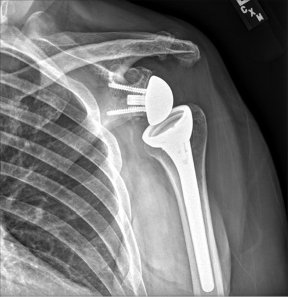- Home
- Dr Shailesh Keshav Mishra
- Arthroscopy
- Joint Replacement surgeries
- Arthritis care
- Type of Sports injuries
- Gallery
- Blogs
- Testimonials
- Contact Us
If you have been suffering from the condition which is commonly called the cuff tear arthropathy, then a total shoulder replacement might not be a good choice for you. In this type of condition, the patients have large rotator cuff tears and if you opt for a total shoulder replacement then you will have to endure a lot of pain.
In a normal (Anatomic) total shoulder replacement, the device that is implanted onto the joint mimics the usual structural descriptions of a shoulder joint. There is a plastic cup like structure that stays fitted into the glenoid cavity and also a metal ball. This is attached to the head of the humerus. But in case of reverse shoulder replacement, the position of the plastic cup and metal ball are switched, that is, the metal ball is placed in the glenoid cavity while the plastic cup at the head of the humerus.


If you are not sure whether reverse shoulder replacement is the surgery that you should undergo, then given below are some of the situations, when this surgery is required:
You should also ask your doctor whether there are other modes of treatment for your condition. You should go for a reverse shoulder replacement when you have tried other modes of treatment like medications, therapy or cortisone injections and all of them have failed.
Making simple changes in your home before surgery can make your recovery period easier. For the first several weeks after your surgery, it will be hard to reach high shelves and cupboards. Before your surgery, be sure to go through your home and place any items you may need afterwards on low shelves. When you come home from the hospital, you will need help for a few weeks with some daily tasks like dressing, bathing, cooking, and laundry.
After your surgery is completed, the doctor will evaluate you and then antibiotics are prescribed to ensure there are no infections in any part of the body. You may also be addressed to undergo physical therapy.
When you leave the hospital, your arm will be in a sling. Your surgeon may instruct you to do gentle range of motion exercises to increase your mobility and endurance. A formal physical therapy program may also be recommended to strengthen your shoulder and improve flexibility.
You should be able to eat, dress, and groom yourself within a few weeks after surgery.